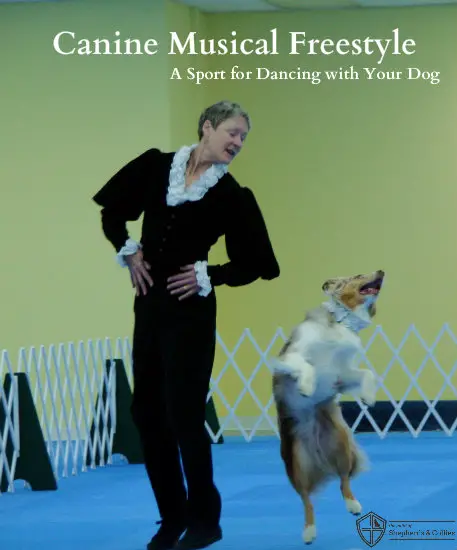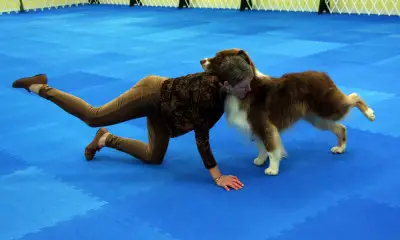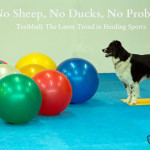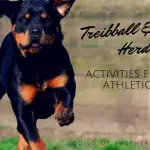Canine Musical Freestyle: It’s Dancing … with Your Dog!

Freestyle Will Get You Dancing with Your Dog
Canine Musical Freestyle is a sport enjoyed by all dogs of all sizes, but we seem to see more herding breed dogs than other types. The dogs choose the music (really!), and there are no handlers. Everyone dances with their own dog. As long as you’re moving with the music, that’s enough.
 In WCFO (World Canine Freestyle Organization, Inc), no one is allowed to do anything that might be dangerous to the dog. Owners can choose to do Heelwork with Music, with the dog no more than 3 ft. away from them, or Musical Freestyle which includes send-outs and other “tricks.”
In WCFO (World Canine Freestyle Organization, Inc), no one is allowed to do anything that might be dangerous to the dog. Owners can choose to do Heelwork with Music, with the dog no more than 3 ft. away from them, or Musical Freestyle which includes send-outs and other “tricks.”
The owners are in costume to suit the music or the skit, and the dogs can only wear a fancy collar and anklets - it’s fun for everyone, of all ages. Categories include Sassy Seniors (Senior dog and/or owner), Handi-Dandi (Handicapped dog and/or owner) and Juniors, whose category is associated with 4-H.
I interviewed three freestylers: Carrie Neri and Paula Winsor from the U.S., and Jana Himmel from Europe. Each had her own reason for choosing Freestyle.
For Carrie Neri, it began with her first Aussie, Keisha. Keisha’s breeder, Diane Dodge of Merimor Aussies, was her instructor who participated in Canine Freestyle, which, at the time, was a brand new sport. Sometimes, before class, she would practice what she learned in freestyle class with her Aussie, Bows. “I was just awestruck,” Carrie remembers. Keisha didn’t like obedience training, so Diane thought she should try freestyle. “I took a class with Donna Duford of Top Hat and Tails Musical Dance Troupe and Keisha just loved it and really thrived in it.” Carrie knew it was the right sport for them. She kept Keisha in Obedience classes and when she moved to Southeastern CT to join Pfizer, she met a whole new group of obedience people.
During a rescue event, she was showing off some of her freestyle moves and someone from the Australian Shepherd Club of America saw her “goofing around” and asked Carrie to do a demo at an upcoming show. Carrie bought some videos, learned to choreograph a routine and performed at the Aussie Rescue show. Carrie and Keisha were a big hit and Aussie people caught onto the “freestyle fun.” Not long after that, at another rescue event, she met Top Hat and Tails members Laurel Rabschutz and Nancy Triou; she showed them what she knew and they invited her to join the team.

Paula Winsor got started because her first Australian Shepherd, Bart “needed a job. And I needed something to train in small spaces in the winter; living room and basement. I had the Sandra Davis videos, then had an opportunity to take classes with Alison Jasciewicz…we got started and have been working on it and loving it ever since.”
For Jana Himmel it was a love of “fun sports”, rather than traditional ones, that led her to Canine Musical Freestyle. She had started years ago in Agility but was never interested in Tracking or anything like that. “I used to do obedience with my previous dog (Briard/Tervueren) because he liked doing it. Then freestyle and rally-o came and we started competing in both. At the next obedience competition, my dog was clearly as bored with obedience as I had been all along. He had found out that there were sports that were more fun to do. What I like about freestyle is that I’m absolutely free to compose my own program - by the Swedish rules at least, no required moves – so that it will suit both my dog and me. Both my dogs and I love training tricks and one of the best parts is putting them together. In freestyle, you can do with your dog what your dog is best at.” Jana doesn’t exactly have a common job, “I work at a theatre which usually has animals onstage, too. Being able to do the tricks at the right timing with as little help as possible, in front of an audience, is part of my dog’s job description. We use freestyle competitions partly as stage training sessions where I – by paying the starting fees – am paying the audience to watch, so it doesn’t matter so much if we mess up!”
There are required moves in World Canine Organization Freestyle but the requirements are geared to each level of competition.
All three agree that it is a great sport for herding breed dogs. “They are generally active, smart, athletic and love to learn and work, which is very reinforcing to the trainer as they are often as eager to work as the trainer is to train,” says Paula. “Also, with thoughtful, positive training, motivation to work and learn is not generally a problem.”
Read about Treibball - a great sport for herding breeds that doesn't require animals - in No Sheep, No Ducks, No Problem
“I think it’s generally a good sport for all breeds because there are almost no requirements,” says Jana. “It’s really a challenging sport and one of the hardest ones to do, but as you compose your program yourself, you can start with whatever dog you happen to own. You can just make it fit. Herding breeds seem to be overrepresented in all sports but I don’t know if that’s because they make good sport dogs or because herding breed owners like doing sports. Probably both,” she muses. “I have owned and trained only French and Belgian herding dogs and freestyle suits them extremely well because it’s a sport where they can really live their inner clown. Their creativity and sense of humor work fine with freestyle but would be less appreciated in obedience.”
“I absolutely think it’s a good sport for herding breeds due to their activity level, focus and passion for being with their ‘person.’ It really strengthened the bond I had with Keisha, and now with my other dogs,” says Carrie.
“I don’t think they have any special training challenges other than liking to bark when they are really happy about what they are doing,” Carrie adds.
“After years as a dog trainer giving classes in different sports, I would say that every dog has special training challenges,” says Jana. “The herding breeds are mainly eager to please, which is an advantage, of course, but many have problems with pressure that a nervous handler puts them through. The Briard I train loves to repeat exercises, but sometimes has difficulties in going to the next level of training. My Picard gets easily bored, hates repetitions and wants to train all different tricks at once. It’s mainly down to individuals but if I have to generalize I would have to say that a (French) herding dog is more into ‘trial and error,’ testing lots of things all at once and missing the one that was right, while other breeds sometimes are more ‘thinking, then doing it right.,’” Jana adds.
All three agree that it’s a great sport for every dog, not just herding dogs.
“For me, freestyle is more about sharing and bonding with your dog and other freestylers, rather than the competition aspect,” says Carrie. “We mostly perform at fundraisers and other rescue events to promote responsible pet ownership and to portray the different sports that you can do with your dog and the amazing ‘tricks,’ or ‘moves’ that you can teach them.” Carrie dances with her Aussie rescues and a Papillon. “I have met so many wonderful people, many have turned out to be some of my best friends, through the sport of Canine Musical Freestyle. This sport has really changed my life and helped to make me the person I am today.”
“I’m a huge fan of freestyle for any dog, but for Herding dogs it is a great, lifelong sport, as it can be done at any age and keep those brilliant minds active and happy,” says Paula. “Long after infirmities of age can preclude many activities and sports from a dog’s life, freestyle can be adapted and enjoyed. That can go for the handler as well!”
“Don’t be afraid of trying freestyle,” Jana adds. “It’s not all about dancing, and if you don’t like to dance, then don’t! Tell a story with your program instead. In the beginning it’s not as hard as it looks and it’s just so much fun to do!”
If you’re interested in trying this sport with your dog, for more information, including e-mail lists, you can start here: http://www.worldcaninefreestyle.org
(Images courtesy of Paula Winsor)
Article By:
Darlene Arden






